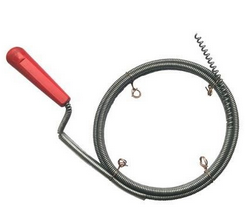My washing machine won’t drain properly, what do I do?
If your washing machine won’t drain properly, don’t panic. It is a fairly common problem, especially if you have a habit of leaving tissues and coins in your pockets. Given enough forgetfulness, even a new washer’s drain can get clogged. So what are you to do? We’re going to look at some of the reasons your washing machine won’t drain and provide some DIY solutions for you to try remedy the problem.
You will need some common household tools and the confidence to remove pipes and use plumbing snakes. You also need to be prepared for a wet mess because all that standing water has to go somewhere, and if you’re not careful it could go all over your shoes and floor. A bucket or plastic container and old towels will do nicely while you drain water from the washing machine.
If you’re not that confident or you don’t want to come into contact with smelly water, contact a professional technician to fix the problem.
Let’s get started so you can unclog your washing machine.
Start by switching off the power or unplugging your washer.
- You need to find your washer’s drain. The instruction manual has diagrams showing you where all the components are, so this shouldn’t be too difficult.
If you can’t find your manual because you put it somewhere safe, the drain pipe is at the back of the washer, along with the hot and cold water pipes. You’ll know the hot and cold water pipes by the colour markings; red for hot and blue for cold.
The washing machine drain pipe also has the water hose attached.
Simple first
- Before you start messing around with the hose, try this simple solution: Boil the kettle and pour hot (not boiling) water in the drain. The hot water will remove layers of soap scum and allow water to drain properly.
Granted, this won’t help if you use a hot wash as a matter of course. But if you stick to cold washes then this could do the trick.
You can also use commercial cleaner to unclog the washing machine drain pipe. Choose a cleaner that is recommended for washer drains and won’t damage the pipe. Be very careful when you use the cleaner, follow the safety instructions, and store out of reach of pets and children.
- Check the filter. It could be blocked by fluff, pet hair, tissues, or any other kind of laundry waste. It’s easier enough to clean.
If, after you try the simple steps, you’ve still got a blocked washing machine pipe you need to get the big boy tools.
You need to remove the back of the washer to get to the drain pipe. Then you have to remove the pipe. Bear in mind that any standing water may flow out immediately, so have your bucket or plastic container and towels handy.
(If you’re going to use a commercial cleaner you will have to remove the drain pipe first and then pour the cleaner in.)
At this point you can “snake the drain”.

- Push the snake into the pipe, corkscrew end first. When you hit something solid, turn the snake so that it snags whatever is blocking the washing machine’s drain pipe. The material gets caught in the snake, clearing the way so you can push the snake further.
Pull out the snake, clean it and push it back into the drain pipe. It’s a good idea to do this until you can go all the way through the pipe to make sure that you’ve removed everything that’s got your washing machine drain clogged.
Then run some hot water through the pipe to rinse it thoroughly and clear any debris that’s barely hanging on.
Reattach the pipe, making sure it’s secure so that your washer doesn’t suddenly develop a leak.
Did you know that the lid or door of your washing machine has to be properly closed for it to drain?
- There is a small switch (the lid switch) that senses when the door is shut so the machine can complete the chosen cycle. If the switch isn’t in the correct position or it’s broken the machine won’t drain.
Find the switch (it’ll be near the door or lid) and press it until you hear a click. If it doesn’t click, it’s broken and probably needs to be replaced.
If it’s still not draining, check the washing machine pump.
- Once again, your owner’s manual will show you where the pump is and what kind of pump will serve as a replacement.
You can remove and replace the pump as a matter of course, which is a good idea if you don’t want to mess around too much with the inner workings but you don’t want to call out a technician either.
If you don’t want the expense of a new pump but you also don’t want to make things worse with amateur tinkering, call a professional technician. It might be that all he has to do is unblock the washing machine pipe; or he might have to replace the belt or repair the impeller. Whatever the problem, your insurance will pay for a professional to do the work.
Once the problem has been fixed, it’s a good idea to get into the habit of keeping your washer clean; this means wiping the drum, wiping the rubber seal, cleaning the filter, and using a descaler on a semi-regular basis (3 – 4 times a year). You should also always check pockets before you put clothes in the machine.
